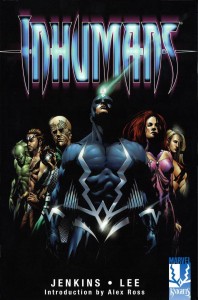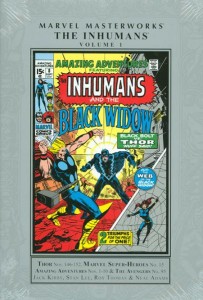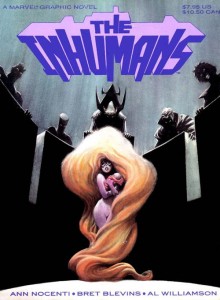 A dysfunctional family with the power to change the world. Sounds like Game of Thrones? More like Arrested Development with superpowers.
A dysfunctional family with the power to change the world. Sounds like Game of Thrones? More like Arrested Development with superpowers.
Created back in 1965 by Stan Lee and Jack Kirby in their seminal run on Fantastic Four, the Inhumans are an ages-old offshoot of the human race genetically engineered by the alien Kree in an attempt to create a new breed of soldiers. The Kree ultimately abandoned the Inhumans out of fear they would rise to overthrow them, leaving the Inhumans a wayward group of outcast living in the most remote corners of the Earth. As part of their rigid societal system, as a rite of passage into adulthood each member of the Inhumans must take part in inhaling the Terrigen Mists — a mutagenic substance which gives them unique superhuman powers. The Inhumans are led by the mysterious Black Bolt, an Inhuman gifted and cursed by the strange Terrigen Mists with a super-destructive voice that forces him to remain mute unless he seeks to use his voice as a weapon. Black Bolt sits at the head of the Inhuman royal family which includes his wife, Medusa, along with others such as Karnak, Gorgon, Triton, Crystal, Maximus and the endearing canine-looking Inhuman Lockjaw.
When they were introduced in Fantastic Four in the late 60s, they were the ultimate group of oddities for the Richards & co. To put it another way, if the Fantastic Four were a late 80s sitcom like Perfect Strangers, the Inhumans would be the crazy out-of-town family who’d guest-star from time to time. Over the years their stories as weaved in and out of the Fantastic Four title, as well as on their own with a series of short-lived ongoing series as well as one-shots and miniseries. The Inhumans has been one of many concepts that Marvel Studios has talked extensively about adapting into a live-action film, and there’s been unconfirmed rumors recently that Marvel will be launching a new Inhumans comic series.
But let’s not wait for that. In this week’s Where Do I Start?, I run down the best texts to better know the Inhumans. Their appearances are stray at times, but I’ve picked out five text. The one notable exclusion here is the Inhumans appearances in Jonathan Hickman’s recent Fantastic Four and FF run; they played a big role in that series with the introduction of the Universal Inhumans, but their story there is told in drips and drabs over the course of 60+ issues with no easy-to-manage collection to focus on their individual story. With that out of the way, on with the show.
 Inhumans: The Inhumans have never been your typical superhero team, and in this 1998 maxiseries Paul Jenkins and Jae Lee stop trying to fight it and follow these strange people’s path and find their own unique story. Created in the first blush of Joe Quesada’s career as editor at Marvel, this gripping piece of fiction mixes political and personal intrigue with the unique ambiance that Lee’s art provides. The story follows the Inhuman people as their society is dealing with two simultaneous threats — an attempted coup by Black Bolt’s brother Maximus, and an impending invasion by outsiders looking to gain entry into the Inhumans’ closed-off home of Attilan. Jenkins mixes in action and intrigue with ideas of class politics within the Inhuman society, as well as a look at the uneasy coming-of-age ceremonies that young Inhumans go through.
Inhumans: The Inhumans have never been your typical superhero team, and in this 1998 maxiseries Paul Jenkins and Jae Lee stop trying to fight it and follow these strange people’s path and find their own unique story. Created in the first blush of Joe Quesada’s career as editor at Marvel, this gripping piece of fiction mixes political and personal intrigue with the unique ambiance that Lee’s art provides. The story follows the Inhuman people as their society is dealing with two simultaneous threats — an attempted coup by Black Bolt’s brother Maximus, and an impending invasion by outsiders looking to gain entry into the Inhumans’ closed-off home of Attilan. Jenkins mixes in action and intrigue with ideas of class politics within the Inhuman society, as well as a look at the uneasy coming-of-age ceremonies that young Inhumans go through.
Marvel Masterworks: Inhumans, Vol. 1: This 240 page tome collects the earliest solo stories for the Inhumans, covering their feature in the back of Amazing Adventures and late 60s issues of Thor along with some interludes from The Avengers and even the forgotten funnies book Not Branch Ecch. Although this doesn’t’ collect their debut in Fantastic Four, these collected stories are arguably better as it shows Jack Kirby writing and drawing the origins of these people — the first in a series of stories of a race of cosmic gods for Kirby that would eventually include the Eternals and then the New Gods over at DC. These stories show the Inhuman society’s growth from being mere experiments of the alien Kree and on through their earliest modern introduction to normal human society.
Fantastic Four Omnibus, Vol. 2: Some say the greatest Inhumans stories are the original ones told by Stan Lee and Jack Kirby in the pages of Fantastic Four, and I can’t really argue with them. Although they play second fiddle to Reed, Sue, Ben and Johnny, there are some standalone and multi-part arcs in this collection that show Inhumans’ first appearances and how they seem so at odds with normal human actions and compunctions. It’s Stan and Jack at their greatest, pushing out all these strange ideas and making them work — with the Inhumans being one of their greatest.
 Marvel Graphic Novel: The Inhumans: Released back in Marvel’s 1980s line of original graphic novels, this story by Ann Nocenti and Bret Blevins has sadly been forgot — but shouldn’t be. It tells the personal story of Medusa as she deals with bearing the child of Black Bolt and heir to the Inhuman empire, with the leaders of the Inhumans attempting to stop her from carrying through with it. This book really goes to the core of the Inhuman’s strict societal code and their attempts and failures to deal with simple human life. Marvel’s collecting this into a trade that comes out in November called Inhumans: By Right of Birth, but I wouldn’t wait six months to track down this great story in back-issue bins.
Marvel Graphic Novel: The Inhumans: Released back in Marvel’s 1980s line of original graphic novels, this story by Ann Nocenti and Bret Blevins has sadly been forgot — but shouldn’t be. It tells the personal story of Medusa as she deals with bearing the child of Black Bolt and heir to the Inhuman empire, with the leaders of the Inhumans attempting to stop her from carrying through with it. This book really goes to the core of the Inhuman’s strict societal code and their attempts and failures to deal with simple human life. Marvel’s collecting this into a trade that comes out in November called Inhumans: By Right of Birth, but I wouldn’t wait six months to track down this great story in back-issue bins.
Marvel Masterworks: Inhumans, Vol. 2: After years of being guest stars and only having back-up feature in other characters books, the Inhumans finally got a shot on their own title in 1975 — with the surprising creative team of Doug Moench and a young but vibrant George Perez. Moench and Perez don’t town down the oddity that is being an Inhuman, and instead capture onto that and see it through the lens of being superheroes. It’s Shakespeare meets superheroes, as the Inhuman monarchy and its members fight amongst themselves and the larger universe in a great proto-event called the War of the Three Galaxies. Make no mistake, these issues shows the creator with some lofty goals — and while their reach ultimately exceeds their grasps, the stories are a great piece of late Silver Age storytelling that gives an intense look at the Inhumans and their unique dynamics.


Excellent starting points. I love these guys. I have fuzzy memories of their appearances from 40 years ago. I recently made aconcerted effort to gather an almost complete set of their appearances. I started with second hand copies of the masterworks, the inhumans 12 parter, the more recent inhumans and fantastic four cross overs in various trades and some flotsam from across the decades. I went through secret wars, decimation and ended up at war of kings! Then I had to read the recent FF series to see the return of black bolt.
Its all good.
I became fascinated by the character Black Bolt from having a 1977 set of Marvel Super Hero Trump cards., mainly because he trounced all the other cards. But I have never read any Inhumans comic. That is apart from their alternate versions in the Ultimate Fantastic Four Annual #1. Mark Millar and Jae Lee’s re-imagining on the Inhumans is utterly brilliant, I could quite happily read an ongoing comic of those characters. Maybe I’ll check out Jenkins and Lee’s series.
Several years ago, I read the original Lee/Kirby Inhumans stories and for the first time really fell for the characters. I also enjoyed how they were used in DnA’s cosmic run (War of the Kings would be where they played the largest part). Honestly, I haven’t been as fond of how Hickman has used the characters . . .
I’ve been meaning to read that Jenkins series, really should do that soon . . .
You should, great story and would be a great outline for a movie treatment.
Yeah the Jenkins & Jae Lee run is solid. My definitive outlook of them as well as DNA’s use. Black Bolt is himself in Illumimati or now called New Avengers but back in Silent War or World War Hulk it ticked me off that he’s a mute due to his voice’s annihilating effects but when used against the Hulk it pushed the Hulk back and made his nose bleed. I guess that demonstrates the power of the Hulk but think it should’ve done more than that.
I loved the Inhumans maxiseries, probably my favorite work that Jae Lee’s worked on. I really want to check these other books as well because I just can’t scratch an itch for the Inhumans like I can for Spider-Man.
I would love it if Marvel would give the characters own series another shot, it’d be just the thing to make me pick up a Marvel book again. And a movie (possibly)? I feel light headed. The only problem I’d see with that is the conflict between Black Bolt and Maximus would be too much like Loki and Thor and so something new would have to be in the movie. Also the thing about the Inhumans having a segregated society with slaves (the underdwellers? Is that what they’re called?), that might bother people. Ooooh, has there been a casting the Inhumans movie article yet?! Billy Crudup as Black Bolt!!!
I can’ help but recommend Silent War by David Hine and Frazer Irving. It was the story that made me care about the Inhumans. A dark, moody, creepy horror story set in the fallout of the Day of M event (I hadn’t read Day of M when I read Silent War and thoroughly enjoyed it, so no previous knowledge required).
I thought the Inhumans series by Sean McKeever with the next generation of Inhumans was pretty good. I loved the Jenkins/Lee book.
I would say the Inhumans are probably my favorite group in all the Marvel Universe.
This is a good article with a lot of useful info regarding a group of characters near and dear to my heart but I am honestly surprised at the number of typos in the article. Someone should be catching these before the article gets posted. Just my $0.02.
The Jenkins trade is excellent, I wasn’t much into any of the marvel ‘space’ stuff but this trade sucked me in and made me interested not only in the inhumans but also the other space themed stories in the marvel U.